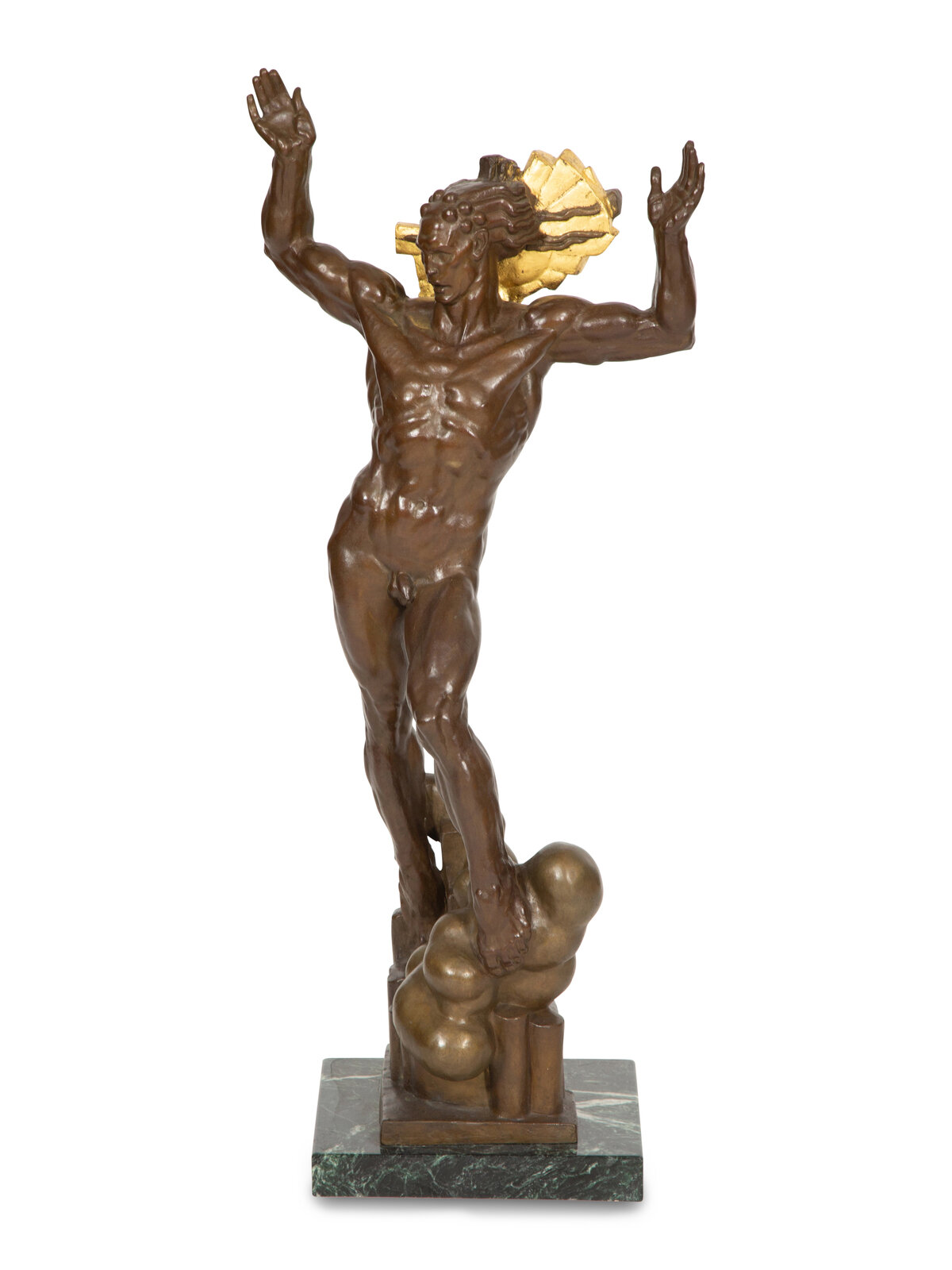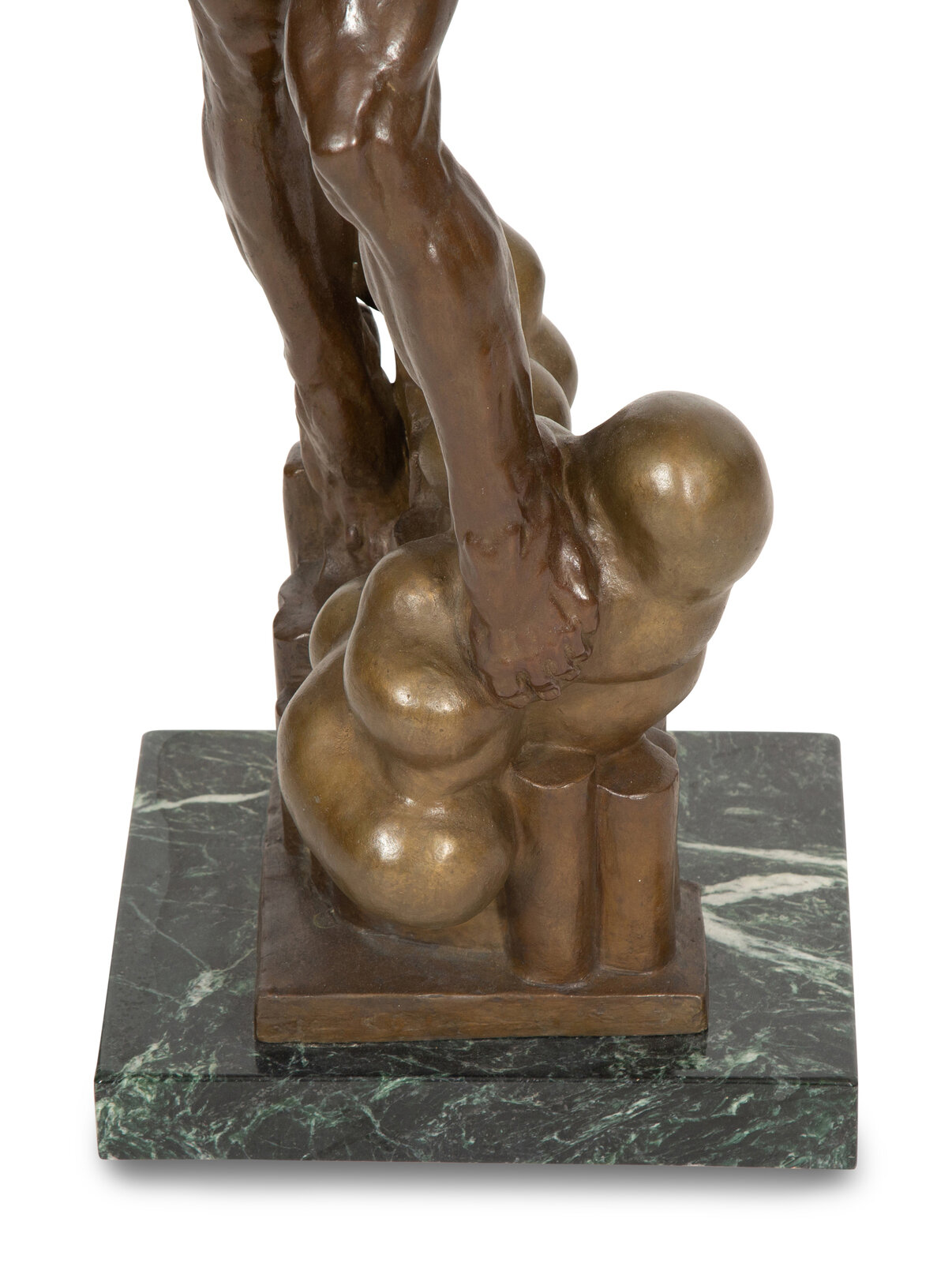Donald de Lue
(American, 1897-1988)
Sun God (Helios)
Sale 1339 - American Art
May 16, 2024
2:00PM CT
Live / Chicago
Estimate
$10,000 -
$15,000
Sold for $10,160
Sold prices are inclusive of Buyer’s Premium
Lot Description
Donald de Lue
(American, 1897-1988)
Sun God (Helios)
bronze with brown patina and applied gilt
signed De Lue, dated SC. 1955 and © 1986, numbered 1/12, and stamped with the TX monogram for the Tallix Foundry in Beacon, New York (upper rear of base)
Height: 34 1/4 inches.
This lot is located in Chicago.
Literature:
D. Roger Howlett, The Sculpture of Donald DeLue: Gods, Prophets and Heroes, Boston, 1990, pp. 26; 30-31; 47; 53; 94; 113 (another cast illustrated)
With a career spanning sixty years, the artist Donald De Lue is considered one of 20th century America’s greatest monumental sculptors in the Realist style. Born in 1897 in Boston, at the age of 12 he apprenticed with Boston sculptor Richard Recchia, and later studied with Bela Pratt at the Museum of Fine Arts, Boston, as well as Robert Baker. After World War I, De Lue spent five years in France, where he worked for several sculptors, including Alfredo Pena. It was under these sculptors’ influence that he learned to sculpt the human body accurately and from memory and began to break away from literal interpretations of his subjects. After he returned to the United States, the artist served from 1923-1938 as chief assistant to the portrait sculptor Bryant Baker in New York City. With Baker, he honed his skills and became known as a “sculptor’s sculptor” for his mastery of anatomy. By the late 1930's, De Lue had developed his mature style, and his own career began to flourish.
“His sculpture demonstrates artistic links to both Greco-Roman and late Renaissance sculptors,” writes Jonathan L. Fairbanks, Emeritus Curator of American Figurative Sculpture Catalogue, Museum of Fine
Arts, Boston. “He emulated the exuberant gestures and energetic composition such as those found at Pergamum. The mature Michelangelo especially inspired De Lue to compose his figures with mannerist proportions, emphasized with highly articulated musculature. However, by combining these older influences with the
ideas and techniques acquired during his stay in Europe… De Lue developed his own synthesis. As he admitted, 'Although my work is traditional, it is a tradition of my own’.”
De Lue’s use of classical mythology and the personification of spiritual ideas is represented in the present sculpture. Originally conceived in 1937, Sun God (Helios) draws heavily on Greek mythology. Like Apollo, Helios drove the sky daily in his four-horse chariot and was known as “untiring,” ”all-seeing,” and “he who makes mortals rejoice.” The artist created the bronze to present at a competition for sculpture on the new Federal Trade Commission Building in Washington, DC and it was likely his first publicly exhibited sculpture, for which he won as
runner-up. With his gold-rayed halo and powerfully raised arms, the figure exudes an intense cosmic strength. As Plato encouraged his followers to do, De Lue looked to the “spangled heavens” for patterns and inspiration to people his own personal pantheon of cosmic beings.
Several government commissions followed, the first of which were reliefs for the Philadelphia courthouse, completed in 1940. In the next almost fifty years, De Lue probably executed more monumental commissions than anyone else of his generation. Most notable are his works Spirit of American Youth Rising from the Waves and Rocket Thrower for the 1964 World's Fair in Flushing Meadows, New York. He was also an accomplished medalist and a member of the National Sculpture Society.
Condition Report
Height with base: 36 5/8 inches.
The physical condition of lots in our auctions can vary due to
age, normal wear and tear, previous damage, and
restoration/repair. All lots are sold "AS IS," in the condition
they are in at the time of the auction, and we and the seller make
no representation or warranty and assume no liability of any kind
as to a lot's condition. Any reference to condition in a catalogue
description or a condition report shall not amount to a full
accounting of condition. Condition reports prepared by Hindman
staff are provided as a convenience and may be requested from the
Department prior to bidding.
The absence of a posted condition report on the Hindman website or
in our catalogues should not be interpreted as commentary on an
item's condition. Prospective buyers are responsible for
inspecting a lot or sending their agent or conservator to inspect
the lot on their behalf, and for ensuring that they have
requested, received and understood any condition report provided
by Hindman.
Please email fineart@hindmanauctions.com for any additional information or questions you may have regarding this lot.















